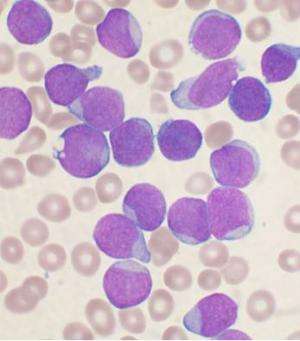An epigenetic marker can predict survival in childhood leukaemia

A molecular epigenetic marker is important for distinguishing patients with childhood leukaemia at high and low risk of relapse even at the time of diagnosis. It can be important to adapt early on as to what treatment to apply, so that children are not exposed to treatment with more severe side effects than necessary. This is shown in a new doctoral thesis at Umeå University, Sweden.
"In the long term, I hope this can pave the way for new tailor-made treatments for leukaemia and lymphoma in children," says Zahra Haider, doctoral student at the Department of Medical Biosciences at Umeå University.
The most common type of cancer in children, acute lymphoblastic leukaemia (ALL), as well as lymphoblastic lymphoma (LBL) are characterised by uncontrolled growth of white blood cells in bone marrow, blood and lymph nodes. Thanks to advanced treatment methods, survival in recent years has greatly improved for ALL/LBL patients.
Today's treatments, however, mean an effective but very tough route to recovery, by the fact that they consist of a combination of toxic drugs. Unfortunately, there are patients who suffer from relapse of the cancer, and for them, survival is very low.
By determining early on which children have high and low risk of relapse, it would be easier to tailor the treatment intensity. The benefit would be that children then do not have to undergo more intensive treatment with severe side effects than what is justified on the basis of their risk profile, while the toughest treatments can be applied to high-risk patients. Also, this subgrouping can be used to identify genes that have different properties between high–risk patients and low-risk patients. These genes can then be targeted for future therapeutic strategies.
Researchers at the Department of Medical Biosciences at Umeå University have studied biological markers that can identify patients who respond differently to treatment and have different relapse risks. In her doctoral thesis, Zahra Haider shows how such a marker, an "epigenetic signature", can be used to classify patients in different subgroups and has also identified significant genes linked to the different subgroups.
The "epigenetic signature" is based on an epigenetic mechanism, DNA methylation, which is a chemical modification of DNA. DNA methylation is altered in different cancers, including leukaemia and lymphomas. The epigenetic signature was analysed in more than 600 Nordic paediatric acute lymphoblastic leukaemia patients, diagnosed between 1992-2013 and could distinguish high and low risk patients at diagnosis; it can significantly predict survival and relapse. The signature could also be seen in childhood and adult acute lymphoma as well as in adult ALL. The researchers could also see that different biological mechanisms including the expression of critical oncogenes are linked to the various epigenetic subgroups. These findings underscore the relevance of DNA methylation signatures in acute leukaemia and lymphomas and identify novel targets for therapy.















